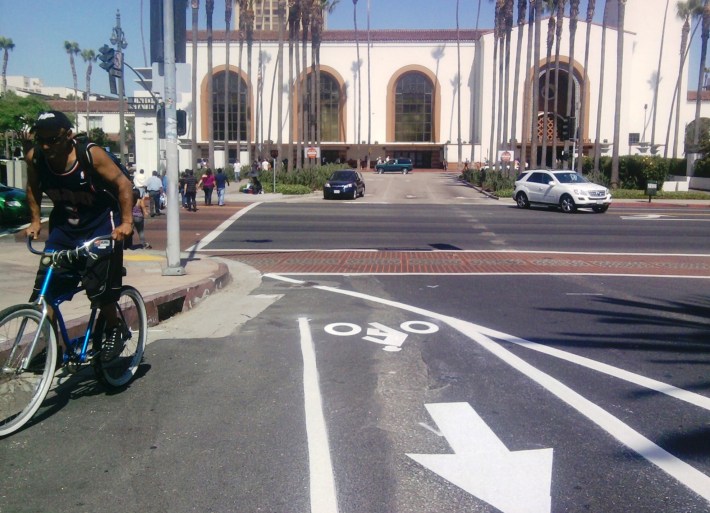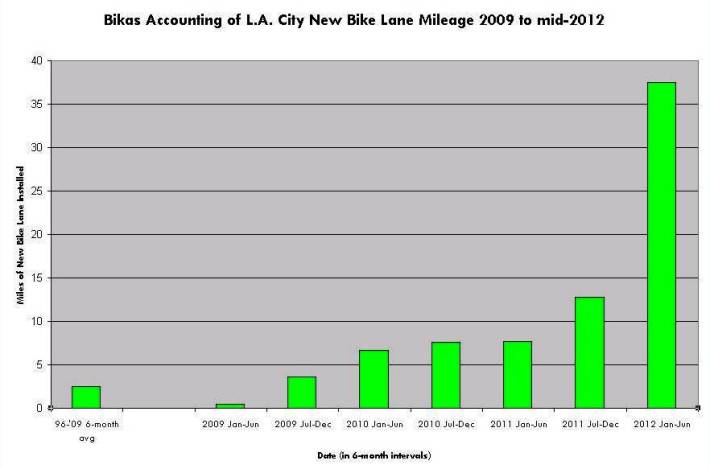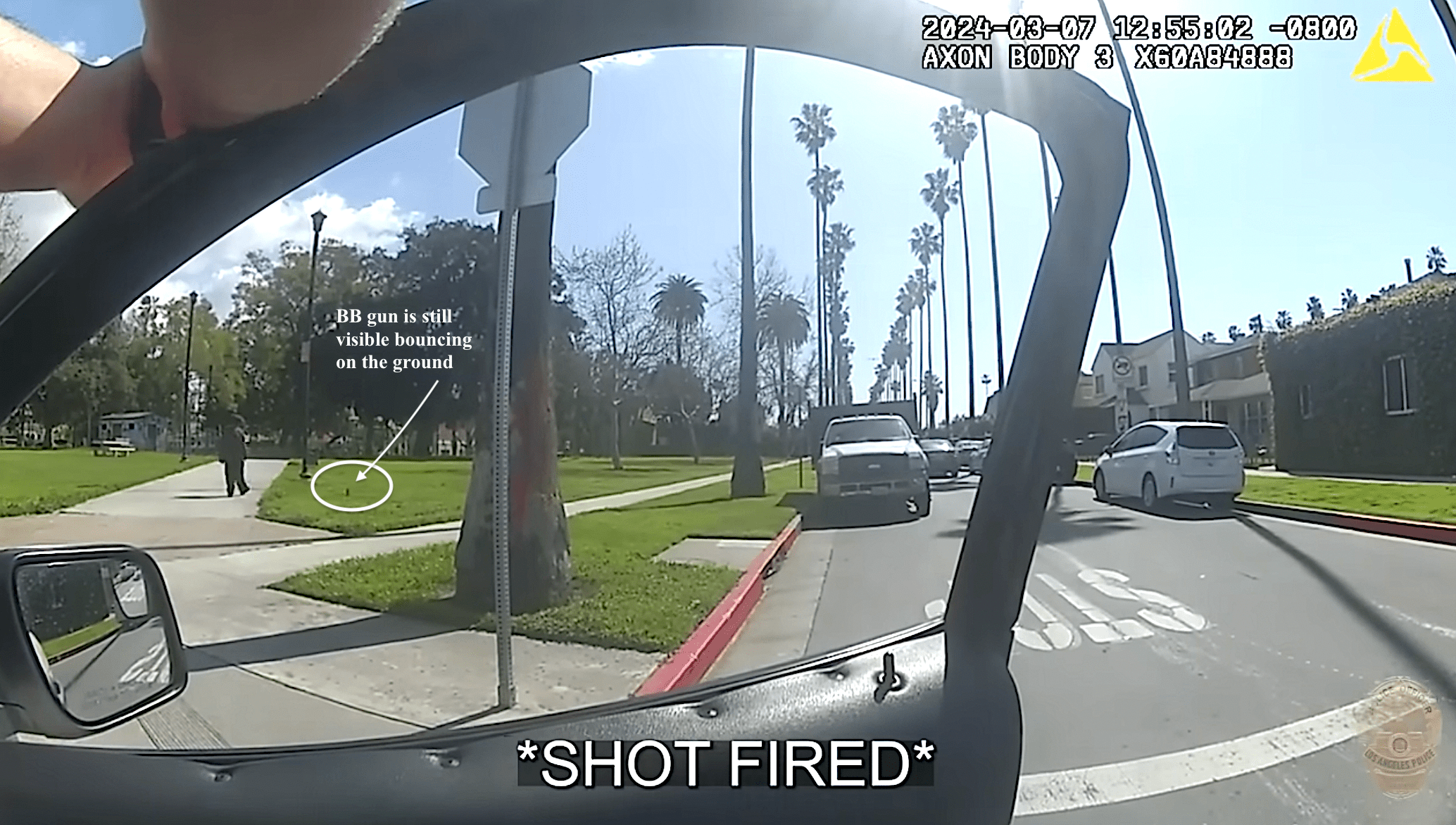LADOT’s FY11-12: A Banner Year for Bikeways
12:42 PM PDT on July 12, 2012
Back in a January 2012 L.A. Streetsblog article, Joe Linton stated that LADOT was "not quite on track" to complete Mayor Villaraigosa's pledge for 40 new miles of bikeway each year. In that article, Linton projected only 31 new miles to be completed during Fiscal Year 2011-2012. The fiscal year ended two weeks ago, and LADOT not only met, but greatly exceeded the 40 new miles pledged.
According to LADOT General Manager Jaime de la Vega, his department delivered 76 new miles of bikeways this year: "51 miles of on-street bike lanes, 21 miles of sharrow-ed routes (bike routes with shared lane markings), and a 4-mile bike path."
Joe Linton has a slightly lower total - 62 new miles, mostly from excluding some of the sharrows projects that were done on existing bike routes, hence Linton doesn't see them as truly "new" mileage.
Taking either mileage figure, it's clear that LADOT not only met but substantially exceeded the pledged minimum of 40 new bikeway miles. This shows on L.A. streets - have you seen new bike lanes and new sharrows on the streets in your neighborhood?
Linton has a report card posted at Bikas that grades the DOT's bike infrastructure work this year. He gives them an overall grade of A-, a very high mark for a department that Linton has been very critical of in the past.
Below are a few excerpts from Bikas report card, which includes grades for quantity, equity, distribution, breadth, innovation, and transparency.
Linton gives the department an A+ for overall quantity:
Quantity: A+
From 1996-2009, the city of Los Angeles averaged about 5 miles of new bike lane each year. During FY2011-2o12 it added 50.2 miles – ten times more than the past average.
I admit that I was skeptical that this would ever happen. When the city’s 5-Year Implementation Strategy showed rough 40 miles per year, then Mayor promised at least 40 new bikeway miles… I truly expected the LADOT not to meet the pledged mileage. (I remember some discussions with bike activists around 2009 – when we were pushing for some targets and accountability to be part of the city’s new bike plan. We were trying to come up with a demand that we’d push the city to commit to. At that time we were thinking 25 miles/year – and I remember thinking that sounded just too high to demand.)
Early in the fiscal year, some of my worst fears appeared to be confirmed when the city initially appeared to ignore its plan and instead sharrow existing bike routes. At the time, city reps publicly stated that the wimpy new sharrow mileage would count toward the 40-miles pledged. At that point, Bikas sounded the alarm; Biking in L.A., LACBC, Bikeside, L.A. Streetsblog and others reiterated the charge. Amazingly (at least for me, one bike advocate who’s gotten used to lowering his expectations) fortunately, the mayor and the DOT got the message. In early calendar year 2012 the city stepped up its game, implementing facilities that only a couple months earlier hadn’t been on their FY11-12 lists. LADOT hustled, worked weekends and overtime, and greatly stepped up bike lane implementation.
All in all, the city implemented ~62.5 miles of new bikeway facilities: 50.26 miles of new bike lane, ~4.2 miles of new bike paths, and ~8 miles of new bike routes with sharrows. (That’s 80% bike lanes, 13% routes, 7% bike paths.) This quantity of new mileage is unprecedented. The mayor, city council, and especially the LADOT deserve praise for greatly exceeding their pledged mileage. For overall quantity, I’m likin’ it.
Linton catalogs LADOT's innovations:
Innovation: B+
FY 2011-2012 saw the city of Los Angeles do a lot of new types of facilities that were either never done here before, or rare.
- Green Lanes: Use of green paint on the First Street and Spring Street bike lanes. Yes, significant portions of the pilot paint has worn off, but, when a city tries new things, some fail somewhat and some lessons are learned.
- Buffered bike lanes: Buffered bike lanes, including nearly all of Spring Street, and portions of Los Angeles Street, First Street, 7th Street, and others.
- Parking Removal: Some removal of on-street parking to create bike lanes, including on Reseda Boulevard (some parking removal also in Lincoln Heights and along Expo was less well executed.)
- Lane / Sharrow Combo: Limited use of sharrows to close fairly short gaps in bike lane facilities, including on Burbank Boulevard and Laurel Canyon Blvd
- Lane Reductions, including Road Diets: Though the majority of new bike lane mileage did not remove travel lanes, a significant minority (my guess ~25-40%) did. While the city has done some of these lane reductions in the past, the recent volume is commendable. FY2011-2012 bike lane projects included road diets on 7th, Main (Venice), Main (South L.A.), Main (downtown). Also elimination of a car lane on theSpring/Main one-way couplet, on Los Angeles Street, and I think maybe some others.
- First One-Way Bike Lanes: L.A. hasn’t done one-way couplets in the past, soSpring/Main and Avenue 18/19 were without a local precedent.
- Interjurisdictional Cooperation: L.A. connected bike lanes with the adjacent cities of Culver City and Santa Monica… can L.A. County and Alhambra be far behind? What’s great about this is that L.A. has now become a regional leader, building bike lanes up to the edges of other municipalities – in effect, challenging them to step up to the plate!
With all that innovation, why only the B+? Well… though L.A. is doing a lot and a lot of stuff that’s new here, we still lack some of the cool new things that many bike-friendly cities are implementing:protected bike lanes, parking-protected bike lanes, bike boulevards, etc.
Linton closes the report card with examples of his favorite 2011-2012 facilities:
7th Street bike lanes: This facility is excellent! It’s a 2.2-mile road diet on the right street. Cyclists already used 7th to avoid hills and freeway on/off ramps. It connects L.A.’s most population dense neighborhoods with its downtown. It’s frequented by many kinds of cyclists from messengers to working class immigrants to businessfolks to you name it. It’s a route I personally use daily; I think that the 7th Street bike lanes are probably the city’s very best transportation accomplishment for improving my personal quality of life… not that that’s their mission, but… hey, I do love the 7th Street bike lanes!
Spring and Main One-Way Couplet: In the heart of downtown, alongside L.A. City Hall, the city removed travel lanes and created an innovative and very useful bike lane couplet.
Road diets on Main Street (Venice), Main Street (South L.A.), and Main Street (Downtown Fashion District.) I think a lot of the bike-ability progress that we’ll see in the near future will be road diets: converting 4-lane streets into 3-lane streets. These three distinct Main Street road diet projects are all excellent in their own ways, and (along with 7th) they demonstrate that road diets are great for bikes and make places safer for all road users. More road diets please!
and list two more Honorable Mentions accomplishments:
- Vineland Avenue (Sun Valley) – excellent opportunist new lanes in a low-income Latino neighborhood with high levels of walking and biking.
- Vermont Avenue (South L.A.) – two long sections (nearly 5 miles) implemented that had been stalled for years due to city/county being unable to work together. These get the foot in the door for a critical backbone facility on one of L.A.’s most prominent north-south streets.
Read the full report card at Bikas. Read LADOT's catalog of FY 2012 Bikeways Accomplishments at the LADOT Bike Blog.
Stay in touch
Sign up for our free newsletter
More from Streetsblog Los Angeles
LAPD shoots, strikes unarmed unhoused man as he walks away from them at Chesterfield Square Park
LAPD's critical incident briefing shows - but does not mention - that two of the three shots fired at 35yo Jose Robles were fired at Robles' back.
Metro Committee Approves 710 Freeway Plan with Reduced Widening and “No Known Displacements”
Metro's new 710 Freeway plan is definitely multimodal, definitely adds new freeway lanes, and probably won't demolish any homes or businesses
Automated Enforcement Coming Soon to a Bus Lane Near You
Metro is already installing on-bus cameras. Soon comes testing, outreach, then warning tickets. Wilshire/5th/6th and La Brea will be the first bus routes in the bus lane enforcement program.






